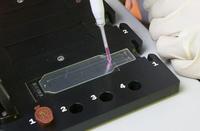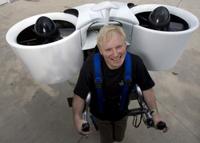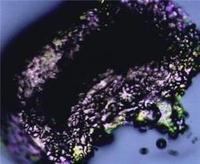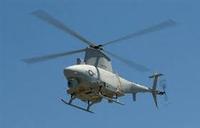-
Invisibility cloak to protect buildings from earthquakes
Scientists show that by cloaking components of structures with pressurized rubber, powerful waves such as those produced by an earthquake would not “see” the building — they would simply pass around the structure and thus prevent serious damage or destruction
-
-
Advances in the use of photocatalysts to help keep water clean safe
Photocatalysis involves the acceleration of chemical reactions using the power of light; researchers experiment with different types of photocatalysts to reduce nitrates in water
-
-
New technology will allow miniaturization of chemical sensors
A new measuring technology – based on measuring near-resonant nonlinear behaviors rather than measuring chemomechanically induced shifts in linear natural frequency – will allow a dramatic miniaturization of sensors; the miniaturization will make these sensors more suitable for first response, law enforcement, and military missions
-
-
Wireless underground robots for first responders
First responders may have to look for victims in hostile or challenging environments, such as clandestine tunnels, subway systems, and underground structures; sending a wireless robot to look around and pull victims out would be safer
-
-
Electron beam reduces virus-related health risk in lettuce, spinach
Current health-care costs in the United States associated with foodborne viruses are estimated at about $6 billion; scientists show that electron-beam irradiation can reduce the health risks in iceberg lettuce and spinach, but note that electron-beams are not meant to be used as a “stand-alone” or “clean-up” technology
-
-
Running robots for hard-to-reach places
A large fraction of the Earth’s surface remains inaccessible to conventional wheeled or tracked vehicles, while animals and humans traverse such terrain with ease and elegance; scientists are working to develop search-and-rescue robots which emulate animal or human walking, thus making them more capable of saving people in hard-to-reach places
-
-
Helicopters emulate humpback whales to become more maneuverable
Humpback whales are renowned for their great speed and acrobatic skills; they achieve both because of their unusually large pectoral fins, which have characteristic bumps along the front edge; researcher say that placing similar bumps on helicopter rotor blades (the technical term is “leading-edge vortex generators”) will increase the speed and maneuverability of helicopters
-
-
Portable device quickly detects pathogens in developing countries

Two Cornell University researchers will combine their inventions to develop a handheld pathogen detector that will give health care workers in the developing world speedy results to identify in the field such pathogens as tuberculosis, chlamydia, gonorrhea, and HIV
-
-
Self-guided bullet can hit target a mile away
Researchers have designed a self-guided bullet; the dart-like, self-guided bullet for small-caliber, smooth-bore firearms that hit laser-designated targets at distances of more than a mile
-
-
First responders could be zipping through skies within two years

Glenn Martin, the inventor of the Martin Jetpack, the world’s first commercially available jetpack, recently spoke with Homeland Security NewsWire’s executive editor Eugene K. Chow; in their interview Martin discusses the technical challenges of developing a viable jetpack, its uses in emergency response, and when we can expect to see civilians zipping through the skies
-
-
World’s first magnetic soap can clean oil spills

A University of Bristol team has dissolved iron in liquid surfactant to create a soap that can be controlled by magnets; the discovery could be used to create cleaning products that can be removed after application and used in the recovery of oil spills at sea
-
-
Helping UAVs to land safely in an emergency

One obstacle to the wider use of UAVs in domestic missions such as law enforcement is the fact that UAV flight plans are set pre-flight, and if something goes wrong and they need to land they have no way to determining where the safest landing spot is; in most cases they just drop; engineers are developing a system which will allow UAVs sense and avoid other traffic and determine appropriate landing spots should the need arise
-
-
New material for building thermonuclear fusion reactors

Two European projects – ITER and DEMO — propose development of fusion reactors that are economically viable; this work depends on the development of new structural materials capable of withstanding damage by irradiation and elevated temperatures resulting from the fusion reaction
-
-
Tails help leaping lizards – and robots – stay in control

A new study examined how lizards manage to leap successfully even when they slip and stumble; the researchers found that lizards swing their tails upward to prevent them from pitching head-over-heels into a rock; the research pushed the boundaries of control in robotics in an area researchers call inertial assisted robotics
-
-
Using bacteria to detect toxins in water
Biologists and bioengineers at UC San Diego have created a living neon sign composed of millions of bacterial cells that periodically fluoresce in unison like blinking light bulbs; because bacteria are sensitive to many kinds of environmental pollutants and organisms, the scientists believe this approach could be used to design low cost bacterial biosensors capable of detecting an array of heavy metal pollutants and disease-causing organisms
-
More headlines
The long view
New Technology is Keeping the Skies Safe
DHS S&T Baggage, Cargo, and People Screening (BCP) Program develops state-of-the-art screening solutions to help secure airspace, communities, and borders
Factories First: Winning the Drone War Before It Starts
Wars are won by factories before they are won on the battlefield,Martin C. Feldmann writes, noting that the United States lacks the manufacturing depth for the coming drone age. Rectifying this situation “will take far more than procurement tweaks,” Feldmann writes. “It demands a national-level, wartime-scale industrial mobilization.”
How Artificial General Intelligence Could Affect the Rise and Fall of Nations
Visions for potential AGI futures: A new report from RAND aims to stimulate thinking among policymakers about possible impacts of the development of artificial general intelligence (AGI) on geopolitics and the world order.
Keeping the Lights on with Nuclear Waste: Radiochemistry Transforms Nuclear Waste into Strategic Materials
How UNLV radiochemistry is pioneering the future of energy in the Southwest by salvaging strategic materials from nuclear dumps –and making it safe.
Model Predicts Long-Term Effects of Nuclear Waste on Underground Disposal Systems
The simulations matched results from an underground lab experiment in Switzerland, suggesting modeling could be used to validate the safety of nuclear disposal sites.
